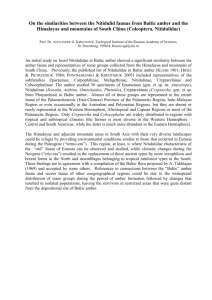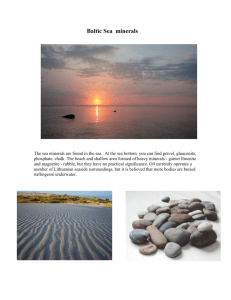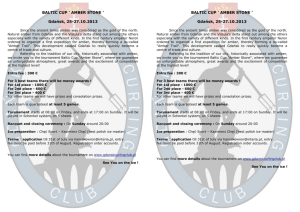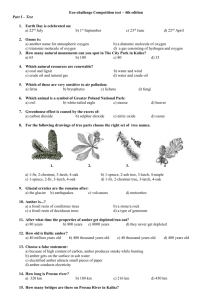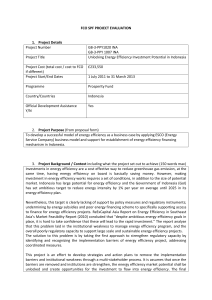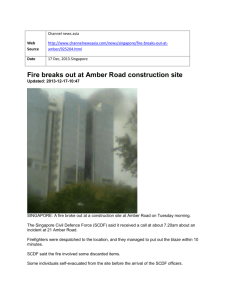a-baker.vp:CorelVentura 7.0 - Institute of Systematics and Evolution
advertisement
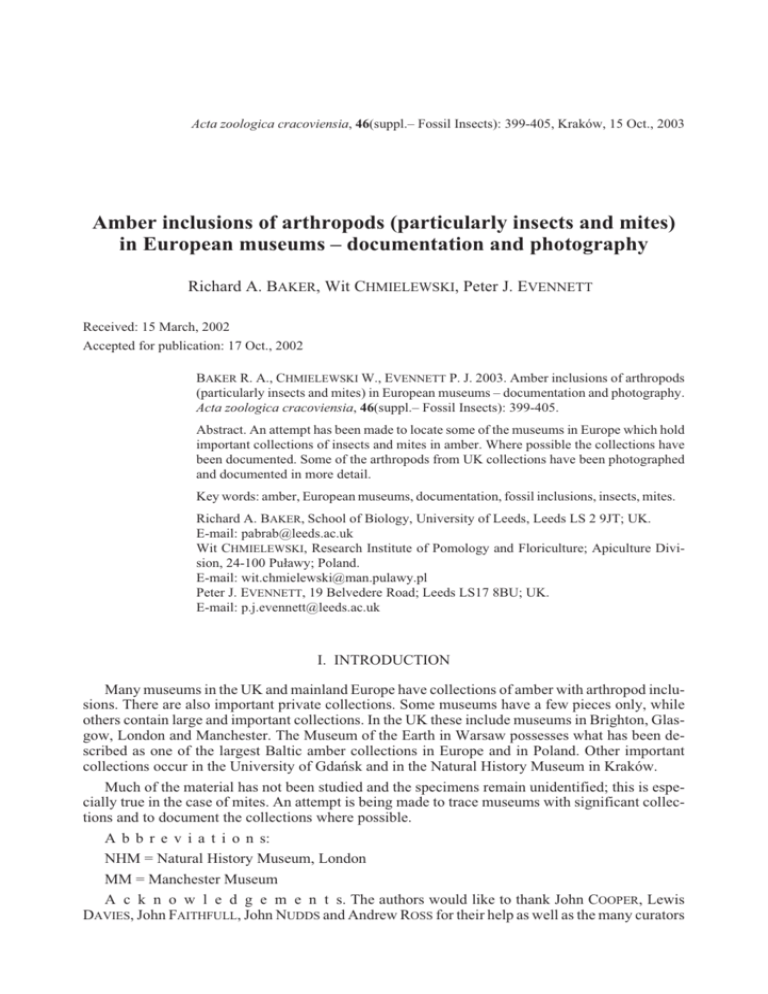
Acta zoologica cracoviensia, 46(suppl.– Fossil Insects): 399-405, Kraków, 15 Oct., 2003 Amber inclusions of arthropods (particularly insects and mites) in European museums – documentation and photography Richard A. BAKER, Wit CHMIELEWSKI, Peter J. EVENNETT Received: 15 March, 2002 Accepted for publication: 17 Oct., 2002 BAKER R. A., CHMIELEWSKI W., EVENNETT P. J. 2003. Amber inclusions of arthropods (particularly insects and mites) in European museums – documentation and photography. Acta zoologica cracoviensia, 46(suppl.– Fossil Insects): 399-405. Abstract. An attempt has been made to locate some of the museums in Europe which hold important collections of insects and mites in amber. Where possible the collections have been documented. Some of the arthropods from UK collections have been photographed and documented in more detail. Key words: amber, European museums, documentation, fossil inclusions, insects, mites. Richard A. BAKER, School of Biology, University of Leeds, Leeds LS 2 9JT; UK. E-mail: pabrab@leeds.ac.uk Wit CHMIELEWSKI, Research Institute of Pomology and Floriculture; Apiculture Division, 24-100 Pu³awy; Poland. E-mail: wit.chmielewski@man.pulawy.pl Peter J. EVENNETT, 19 Belvedere Road; Leeds LS17 8BU; UK. E-mail: p.j.evennett@leeds.ac.uk I. INTRODUCTION Many museums in the UK and mainland Europe have collections of amber with arthropod inclusions. There are also important private collections. Some museums have a few pieces only, while others contain large and important collections. In the UK these include museums in Brighton, Glasgow, London and Manchester. The Museum of the Earth in Warsaw possesses what has been described as one of the largest Baltic amber collections in Europe and in Poland. Other important collections occur in the University of Gdañsk and in the Natural History Museum in Kraków. Much of the material has not been studied and the specimens remain unidentified; this is especially true in the case of mites. An attempt is being made to trace museums with significant collections and to document the collections where possible. A b b r e v i a t i o n s: NHM = Natural History Museum, London MM = Manchester Museum A c k n o w l e d g e m e n t s. The authors would like to thank John COOPER, Lewis DAVIES, John FAITHFULL, John NUDDS and Andrew ROSS for their help as well as the many curators R. A. BAKER 400 who provided information about their collections. The curator of geology (J. NUDDS) at The Manchester Museum and the curator of fossil arthropods (A. ROSS) at The Natural History Museum in London arranged for the loan of material. II. RESULTS AND DISCUSSION Details have been obtained from public museums in Europe where there are important amber collections containing arthropod inclusions. Tables I and II list some of these museums and their collections. POINAR (1992) and ROSS (1998) are useful general references. Insects form the major component of the inclusions in Baltic amber and virtually all of the present day orders are represented, although some are rare. POINAR (1992) describes the various insect Table I Some of the public museums in Europe containing Baltic amber (modified from POINAR 1992) European city Name of institution Estimated number of pieces of baltic amber Berlin Paläeontology Dept. Zoology Dept., Humboldt University Museum 15000 1000 to 2000 Copenhagen Zoology Museum 8000 Gõttingen Institute for Geology and Paläeontology 11000 Hamburg Geological Institute 5000 St Petersburg Zoological Institute 25000 London Natural History Museum 5000 Moscow Geological Institute 5000 Palanga, Lithuania Amber Museum 25000 Paris National Museum of Natural History 2000 Stuttgart Natural History Museum 2500 Warsaw Museum of The Earth 25000 _______________________________________________________ Opposite page:Fig. 1 (top left). Arrangement of amber specimen for photography. Fig. 2 (top right). Mite with insect (Chironomidae). Baltic amber. NHM In. 18697. Fig. 3 (bottom left). Same, higher magnification. Fig. 4 (bottom right). Actinedida (Prostigmata). Bdella (Bdellidae); Baltic amber, NHM In. 18859. Amber inclusions of arthropods 401 402 R. A. BAKER Amber inclusions of arthropods 403 Table II Some of the public museums in the UK containing collections of amber with insects and mites (* insects and arachnids) City/Town Name of institution Source of amber Brighton Booth Museum Baltic Cambridge Univiversity Museum of Dominican Zoology Cambridge Sedgwick Museum Number Estimate Estimate Reference/ Source of of number of number of information pieces insects mites 300 25 Baltic 200 Baltic 222 530 168 Brighton, John COOPER and Museum Report Ray SYMONDS rjs13@cam.ac.uk 25 (Phorid insects) Mike DORLING mgd2@esc.cam.ac.uk 377 14 John FAITHFULL Alfred CORREYA Alfred CORREYA Manager@museum.gla.ac.uk collection only collection only Glasgow Hunterian Museum, University of Glasgow London Baltic 5000 Natural History Museum Burmese 111 Dominican 650 8000* 1200* 1000* 300 164 6 POINAR (1992), RASNITSYN & ROSS (2000) and Andrew ROSS A.Ross@nhm.ac.uk Sheffield Sheffield City Museum Baltic 90 87 10 (Arachnids) Gaynor BOON gaynor.boon@sheffieldgal leries.org.uk Manchester The Manchester Museum, Baltic University of Manchester 84 100 0 JOHNSON and SCHOFIELD (1991) groups found in amber. There have been detailed descriptions of some groups, for example, ENGEL (2001) published a substantial and valuable monograph on Baltic amber bees. Published lists of Baltic amber inclusions include those of KEILBACH (1982a, 1982b) and SPAHR (1981a, 1981b, 1985, 1987, 1988, 1989, 1990, 1992, 1993a, 1993b). WUNDERLICH (1986) amber spider book and WEITSCHAT and WICHARD (1998) atlas are important basic references. ROSS (1998) refers to about 5,000 insect species which have been described from Baltic amber and estimates that the Baltic insect fauna in the Tertiary period may have been as many as 10,000 species. The Museum of the Earth in Warsaw has one of the largest collections (KULICKA, KRZEMIÑSKI and SZADZIEWSKI, 1985) which is particularly strong on Baltic amber. By the early 1990’s, it had 17,000 animals in amber, 90% of which are insects and 60% of these are Diptera. KULICKA (1993) produced a checklist of arthropod inclusions and MAGOWSKI and TOBOLEWSKI (unpublished data) a list of Acari from this museum. Other Polish museums having significant amber collections, with acaro-entomological inclusions yet to be studied, include those at Gdañsk, Kraków, £om¿a and Malbork. At the University Museum in the Department of Invertebrate Zoology at the University of Gdañsk, there are approximately 4500 pieces of amber and 11,000 inclusions of arthropods. Of these about 10,000 are insects, especially Diptera (5700) and Hymenoptera (E. SONTAG 2000 and this volume). The Natural His_______________________________________________________ Opposite page. Fig. 5 (top left). Hymenoptera, Proplebeia (Apidae), Dominican amber, MM.LL11927. Fig. 6. (top right). Hemiptera, probably Fulgoromorpha; Baltic amber, MM. LL11927. Fig. 7 (bottom left) Diptera, Tachinidae. Baltic amber. MM. LL11928. Fig. 8 (bottom right). Diptera, Sciaridae, Baltic amber, MM. LL11956 (64). 404 R. A. BAKER tory Museum of the Institute of Systematics and Evolution in Kraków contains the SERAFIN collection which has not been catalogued but is made up of approximately 1330 pieces of amber. In total the museum houses about 3500 pieces of amber (including the SERAFIN collection). In addition staff have their own private collections, which are consecutively deposited in the museum. As with many other museums, new material is arriving at Kraków on a regular basis and the number of pieces and specimens are not constant. Fossil Diptera in Baltic amber in the collection of the Museum d’ histoire Naturelle at Neuchâtel form the dominant group and represent about 90% of the collection having about 4600 specimens and 38 families (HAENNI, this volume). It is important to emphasize that there are many other European institutions with important amber collections containing inclusions and that this article deals with only some of these. Most are listed in KRUMBIEGEL & KRUMBIEGEL 2001. In the UK many museums have some amber, the bulk of which is Baltic, but the collections at The Hunterian Museum in the University of Glasgow, The PANETH Collection in The Manchester University Museum (JOHNSON and SCHOFIELD 1991), the Baltic amber at The Booth Museum in Brighton (ANONYMOUS report) and the Baltic, Dominican and Burmese amber at The Natural History Museum in London appear to be the main material. Table II lists some of the museums in the UK housing collections of insects and mites in amber. The Natural History Museum in London has about 300 mites in Baltic amber of which only one has been named, Carabodes gerberi SELLNICK 1931 (Holotype, In. 64399, Eocene, East Prussia). Some of the Burmese amber mites (164) there have been identified to family by A. L. KARTSEV and O. L. MAKAROVA (RASNITSYN & ROSS 2000). Cheyletus burmiticus COCKERELL 1917 (Holotype, In 19115, Upper Cretaceous, Myanmar) has been described from Burmese amber. At London, type and figured specimens of insects in Burmese amber (ROSS & YORK 2000) and a preliminary list of arthropod families in Burmese amber have recently been published (RASNITSYN & ROSS 2000). Many of the world’s amber mites have been listed by POINAR 1992 and SPAHR 1993a. Oribatid mites are the most common group in Baltic amber (LARSSON 1978), the Copenhagen collection alone includes 108 specimens. In general terms however, as SELDEN (1993) indicates, many mite families, from the various groups of the Acari, are found in amber. At Brighton, 694 fossil inclusions in Baltic amber have been identified by the Moscow palaeoentomological group led by A. P. RASNITSYN. The majority of these are insects but there are 168 Acarina. This representative collection was gathered at Kaliningrad (unpublished report) and processed there in 1992. The mite photographs illustrating this account are from the collections in the Natural History Museum in London. The insect photographs illustrated here are from the F. A. PANETH Collection held in the Manchester University Museum. Professor PANETH occupied the Chair of Chemistry at K`nigsberg in East Prussia (now Kaliningrad) from 1929, where his interest in amber began. He later moved to Britain. The insect inclusions in this collection were identified by Lewis DAVIES, formerly of the Department of Zoology at the University of Durham, UK (JOHNSON and SCHOFIELD, 1991). All the photographs were taken with a Zeiss stereomicroscope using a Nikon Coolpix 990 digital camera. REFERENCES ANONYMOUS. Baltic amber Collection. Booth Museum of Natural History Brighton and Hove, UK. 40pp. (Undated and unpublished report). ENGEL M. S. 2001. A monograph of the Baltic amber bees and evolution of the Apoidea (Hymenoptera). Bulletin of the American Museum of Natural History, 259: 1-192. HAENNI J.-P. 2002. Fossil Diptera in Baltic amber: the collection of the Muséum d’histoire naturelle Neuchâtel. Proceedings of the II International Congress on Palaeontomology, Kraków 2001. Acta zoologica cracoviensia, this volume. JOHNSON G. A. L., SCHOFIELD D. L. 1991. The F. A. PANETH collection of East Prussian amber. Geological Curator, 5(6): 219-224. Amber inclusions of arthropods 405 KEILBACH R. 1982a. Bibliographie und liste der Arten tierischer Einschlusse in fossilen Harzen sowie ihrer Aufbewahrungsorte. Deutsche Entomologische Zeitschrift, 29(1-3): 129-286. KEILBACH R. 1982b. Bibliographie und liste der Arten tierischer Einschlusse in fossilen Harzen sowie ihrer Aufbewahrungsorte. Deutsche Entomologische Zeitschrift, 29(4-5): 301-491. KRUMBIEGEL G., KRUMBIEGEL B. 2001. Faszination Bernstein. Kleinod aus der Wunderkammer der Natur. Goldschneck-Verl., Weinstadt. 112pp. KULICKA R. 1993. Uwagi o kolekcji inkluzji zwierzêcych w bursztynie ba³tyckim ze zbiorów Muzeum Ziemi PAN w Warszawie. [Remarks about collection of animal inclusions in Baltic amber from the collections of the Museum of the Earth, PAS in Warsaw ]. Annals of the Upper Silesian Museum, Natural History, 13: 49-56. (In Polish). KULICKA R., KRZEMIÑSKI W., SZADZIEWSKI R. 1985. A collection of Diptera Nematocera in Baltic amber at the Museum of the Earth in Warsaw. Prace Muzeum Ziemi, 37: 105-111. LARSSON S. G. 1978. Baltic amber – a palaeobiological study. Entomonograph 1. Scandinavian Science Press, Klampenborg, Denmark. MAGOWSKI W., TOBOLEWSKI J. (unpublished data). Systematyczny spis inkluzji w Muzeum Ziemi PAN (Warszawa). Arachnida (pajêczaki): Acari (roztocze). [Systematic list of inclusions in the Museum of the Earth, PAS (Warsaw). Arachnida (arachnids): Acari (mites)] 1-5. (In Polish). POINAR G. O. 1992. Life in amber. Stanford University Press, Stanford, California. RASNITSYN A. P., ROSS A. J. 2000. A preliminary list of arthropod families present in the Burmese amber collection at The Natural History Museum, London. Bulletin of the Natural History Museum. Geology Series, 56(1): 21-24. ROSS A. 1998. Amber – the natural time capsule. The Natural History Museum, London. ROSS A. J., YORK P. V. 2000. A list of type and figured specimens of insects and other inclusions in Burmese amber. Bulletin of the Natural History Museum. Geology Series, 56(1): 11-20. SELDEN P. A. 1993. Arthropoda. (Aglaspidida, Pycnogonida and Chelicerata) [In:] M. J. BENTON (Ed.) – The Fossil Record 2. Chapman and Hall, London. Pp: 297-320. SONTAG E. 2002. Animal inclusions in a sample of unselected Baltic amber. Proceedings of the II International Congress on Palaeontomology, Kraków 2001. Acta zoologica cracoviensia, this volume. SPAHR VON U. 1981a. Bibliography of Coleoptera in amber and copal. Stuttgarter Beiträge zur Naturkunde, Serie B (Geologie und Paläontologie), 72:21. SPAHR VON U. 1981b. Systematic catalogue of Coleoptera in amber and copal. Stuttgarter Beiträge zur Naturkunde, Serie B (Geologie und Paläontologie), 80: 107. SPAHR VON U. 1985. Supplements and corrections to R. KEILBACH‘s bibliography and list of amber fossils – Order Diptera. Stuttgarter Beiträge zur Naturkunde, SerieB (Geologie und Paläontologie), 111: 146. SPAHR VON U. 1987. Supplements and corrections to R. KEILBACH‘s bibliography and list of amber fossils – Order Hymenoptera. Stuttgarter Beiträge zur Naturkunde, Serie B (Geologie und Paläontologie), 127: 121. SPAHR VON U. 1988. Supplements and corrections to R. KEILBACH‘s bibliography and list of amber fossils – Superorder Hemipteroidea. Stuttgarter Beiträge zur Naturkunde, Serie B (Geologie und Paläontologie), 144:60. SPAHR VON U. 1989. Supplements and corrections to R. KEILBACH‘s bibliography and list of amber fossils – Superorder Mecopteroidea Stuttgarter Beiträge zur Naturkunde, Serie B (Geologie und Paläontologie), 157: 87. SPAHR VON U. 1990. Supplements and corrections to R. KEILBACH‘s bibliography and list of amber fossils – Apterygota. Stuttgarter Beiträge zur Naturkunde, Serie B (Geologie und Palaontologie), 166: 23. SPAHR VON U. 1992. Supplements and corrections to R. KEILBACH bibliography and list of amber fossils – class Insecta. Stuttgarter Beiträge zur Naturkunde, Serie B (Geologie und Paläontologie), 182: 102. SPAHR VON U. 1993a. Supplements and corrections to R. KEILBACH’s bibliography and lidt of amber fossils – various animal groups, except Insecta and Araneae. Stuttgarter Beiträge zur Naturkunde, Serie B (Geologie und Paläontologie), 194: 77. SPAHR VON U. 1993b. Systematic catalogue and bibliography of Flora in amber and copal. Stuttgarter Beiträge zur Naturkunde, Serie B (Geologie und Paläontologie), 195: 99. WEITSCHAT W., WICHARD W. 1998. Atlas der Pflanzen und Tiere im Baltischen Bernstein. Pfeil, Munchen. 256pp. WUNDERLICH J. 1986. Spinnenfauna gestern und heute. Fossile Spinnen in Bernstein und ihre heute lebenden Verwandten. Bauer bei Quelle u. Meyer, Wiesbaden. 283pp.
